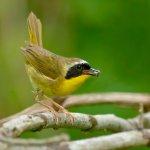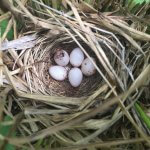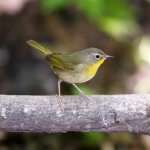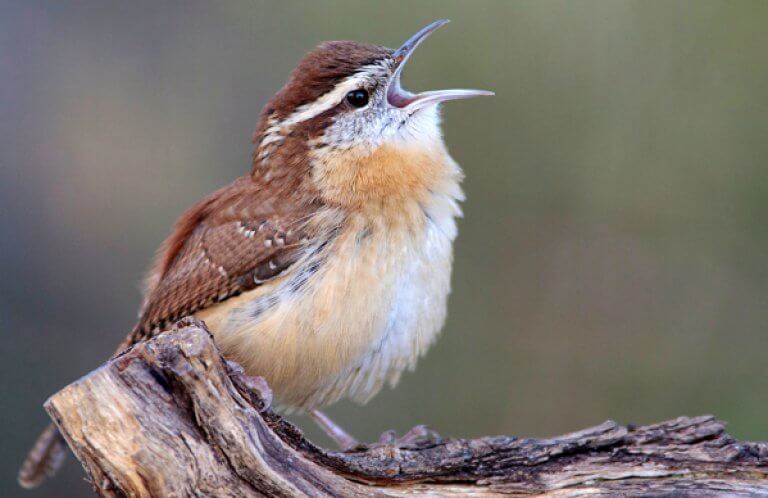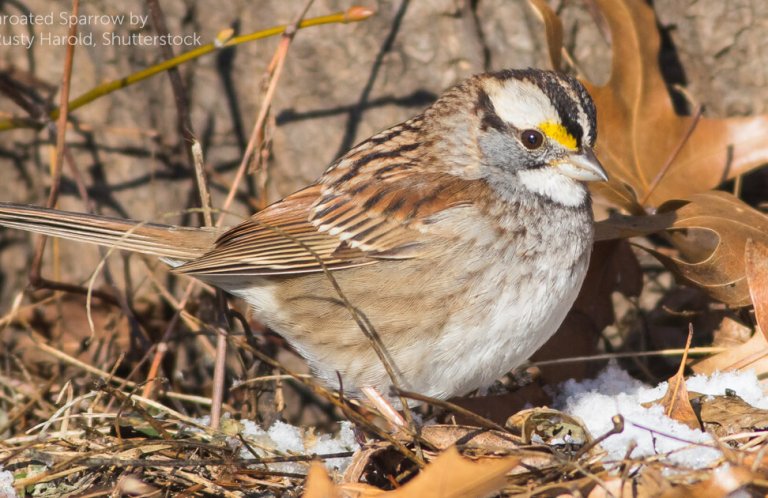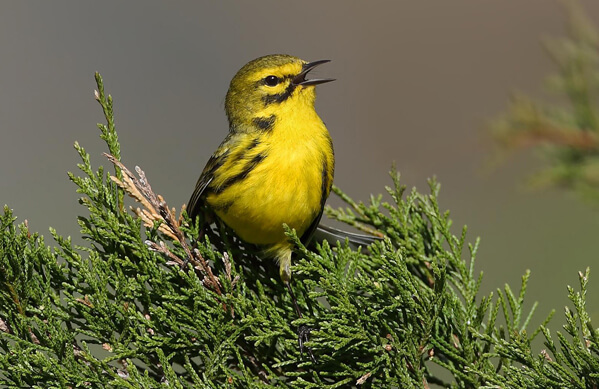About the Common Yellowthroat
The Common Yellowthroat is a warbler that behaves more like a Carolina Wren: It bounces through thick, low vegetation and reeds, rarely far above the ground, and it is heard more often than seen. A quick glimpse of this skulker reveals a short-winged, short-tailed bird, often with a jauntily cocked tail. The male is easily identified by its black "bandit" mask, whereas the female is a more subtle brownish-green with a yellow throat and unmarked face.
This charming, ubiquitous warbler was one of the earliest species of birds in North America to be described by European naturalists, and was initially dubbed the Maryland Yellowthroat, since it was first found in that state.
Although still widespread, the Common Yellowthroat often falls victim to a particular human-caused threat.
A Crashing Conundrum
The Common Yellowthroat, like the Ruby-throated Hummingbird and White-throated Sparrow, is one of the most frequent victims of collisions with windows and communications towers, often during its nocturnal spring and fall migrations.
Birds hit glass because they perceive the reflections of vegetation, landscapes, or sky in the material as real and attempt to fly to or through it, resulting in often-fatal collisions. While birds may learn to avoid a specific window, they cannot generalize, so do not recognize glass windows and other manmade structures as threats in general.
Songs and Sounds
The Common Yellowthroat sings a distinctive "witchity-witchity-witchity" song. It also has a tell-tale call note: a hard, twangy-sounding “chek.” Listen here:
Song:
Call:
Breeding and Feeding
Secretive Nester
Male Common Yellowthroats display in flight, somewhat like a miniature Yellow-breasted Chat. During this display, the male ascends into the air while uttering a jumble of high-pitched notes, then drops back down into cover.

Like Golden-winged Warbler and Prairie Warbler females, Common Yellowthroat females build their nest on or near the ground. To foil potential predators, parent birds deliver food to their chicks by dropping into the thickest vegetation near the nest, sneaking over, feeding their chicks, and departing by another route. Despite these precautions, their nests are often parasitized by Brown-headed Cowbirds.
Like other warblers, the Common Yellowthroat is mainly insectivorous. It feeds by gleaning on the ground or through low, thick vegetation, seeking insects, larvae, and spiders. On its wintering grounds it may add seeds and fruit to its diet.
Region and Range
Widespread Wetland Warbler

Widespread across much of North America during the breeding season; winters in the Caribbean, Central America and Mexico, although a significant part of the population remains in the southern U.S. states. The Common Yellowthroat is usually found near wet, marshy areas with emergent vegetation, but may also be found in other thick vegetation and tall prairie with no water.
This warbler shows a tremendous amount of variability, with 13 recognized subspecies and many more subspecies that will likely be described in the future. Subspecies differ mainly in the males' facial patterns and the brightness of their yellow underparts. Its distinctive song even varies depending on the bird's location, and many subspecies have distinct regional "accents."
Conservation of the Common Yellowthroat
Continent-wide Conservation
In addition to glass collisions, the biggest threats to this cheerful little warbler come from climate change and habitat loss. American Bird Conservancy's (ABC's) BirdScapes approach to conservation is helping counter the declines of migratory birds such as the Common Yellowthroat by working to meet habitat needs across their full annual life cycles.

Help support ABC's conservation mission!
ABC also focuses on addressing the problems of glass and tower collisions, which kill millions of birds each year in the United States alone. Home windows account for nearly 50 percent of all bird collisions, but fortunately, research has identified ways to alert birds to the threat posed by glass. The easiest solution is to apply visible patterns to the outside of the window. Learn more at www.birdsmartglass.org.
In addition, ABC works with partners to advocate for legislation at state and federal levels that establishes bird-friendly building standards. New York City and Washington, D.C. recently passed such bird-friendly building legislation. Our Collisions Program offers many resources for those interested in passing similar legislation in their communities.
Get Involved
Policies enacted by the U.S. Congress and federal agencies, such as the U.S. Fish and Wildlife Service, have a huge impact on migratory birds. You can help shape these rules for the better by telling lawmakers to prioritize birds, bird habitat, and bird-friendly measures. To get started, visit ABC's Action Center.
Living a bird-friendly life can have an immediate impact on migratory birds in the United States. Doing so can be as easy as adding native plants to your garden, avoiding pesticides, and keeping cats indoors. To learn more, visit our Bird-Friendly Life page.
American Bird Conservancy and our Migratory Bird Joint Venture partners have improved conservation management on more than 8.5 million acres of U.S. bird habitat — an area larger than the state of Maryland — over the last ten years. That's not all: With the help of international partners, we've established a network of more than 100 areas of priority bird habitat across the Americas, helping to ensure that birds' needs are met during all stages of their lifecycles. These are monumental undertakings, requiring the support of many, and you can help by making a gift today.






































